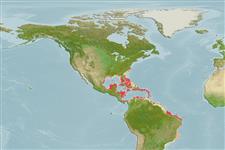>
Holocentriformes (Squirrelfishes, soldierfishes) >
Holocentridae (Squirrelfishes, soldierfishes) > Holocentrinae
Etymology: Holocentrus: Greek, holos = full + Greek, kentron = sting (Ref. 45335).
More on author: Walbaum.
Environment: milieu / climate zone / depth range / distribution range
Ecologie
marien rifbewoner; diepte 0 - 32 m (Ref. 3724). Tropical; 36°N - 28°S, 98°W - 31°W
Western Atlantic: Bermuda and southern Florida, USA to northern South America and Brazil; throughout the West Indies (Ref. 3724). Antilles, northwestern Gulf of Mexico, Yucatan to Colombia (Ref. 26938).
Lengte bij maturiteit / Grootte / Gewicht / Leeftijd
Maturity: Lm 13.5 range ? - ? cm
Max length : 35.0 cm TL mannelijk / geslacht onbekend; (Ref. 5217); common length : 25.0 cm TL mannelijk / geslacht onbekend; (Ref. 5217)
Dorsale stekels (totaal) : 11; Dorsale zachte stralen (totaal) : 14 - 16; Anale stekels: 4; Anale zachte stralen: 9 - 11. Conspicuous white spot behind tip of each dorsal spine (Ref. 26938). Body slender. Upper jaw extending posteriorly to middle of pupil (Ref. 37108). Body bright red or red striped, sometimes blotched (Ref. 7251). Similar in color to H. ascensionis, but each interspinous membrane of dorsal fin with a white spot near margin (Ref. 13442).
Nocturnal (Ref. 37108), inhabits clear reefs (Ref. 5217). Found near mouths of caves and holes (Ref. 26938); at night they usually move to sandy areas and grass beds to feed on crabs, shrimps, gastropods and brittle stars (Ref. 3724). Marketed fresh but not popular as a food fish (Ref. 5217).
Levenscyclus en paargedrag
Maturities | Voortplanting | Spawnings | Egg(s) | Fecundities | Larven
Robins, C.R. and G.C. Ray, 1986. A field guide to Atlantic coast fishes of North America. Houghton Mifflin Company, Boston, U.S.A. 354 p. (Ref. 7251)
Status op de Rode Lijst van het IUCN (Ref. 130435)
Gevaar voor de mens
Reports of ciguatera poisoning (Ref. 30303)
Gebruik door de mens
Visserij: van minder commercieel belang; Aquarium: Commercieel
Tools
Speciale rapporten
Download XML
Internetbronnen
Estimates based on models
Preferred temperature (Ref.
123201): 23.9 - 28.1, mean 27.3 °C (based on 817 cells).
Fylogenetische diversiteitsindex (Ref.
82804): PD
50 = 0.7500 [Uniqueness, from 0.5 = low to 2.0 = high].
Bayesian length-weight: a=0.01175 (0.00709 - 0.01948), b=2.89 (2.75 - 3.03), in cm total length, based on LWR estimates for this species & (Sub)family-body (Ref.
93245).
Trofisch niveau (Ref.
69278): 3.5 ±0.4 se; based on diet studies.
Generation time: 1.2 ( na - na) years. Estimated as median ln(3)/K based on 1
growth studies.
Weerstandsvermogen (Ref.
120179): Hoog, minimale populatieverdubbelingstijd minder dan 15 maanden (K=0.9).
Fishing Vulnerability (Ref.
59153): Low vulnerability (19 of 100).
Nutrients (Ref.
124155): Calcium = 60 [28, 192] mg/100g; Iron = 0.729 [0.304, 1.443] mg/100g; Protein = 18.8 [17.6, 19.9] %; Omega3 = 0.149 [0.062, 0.348] g/100g; Selenium = 37.2 [22.2, 66.9] μg/100g; VitaminA = 49.5 [19.4, 131.3] μg/100g; Zinc = 1.26 [0.82, 1.95] mg/100g (wet weight);
